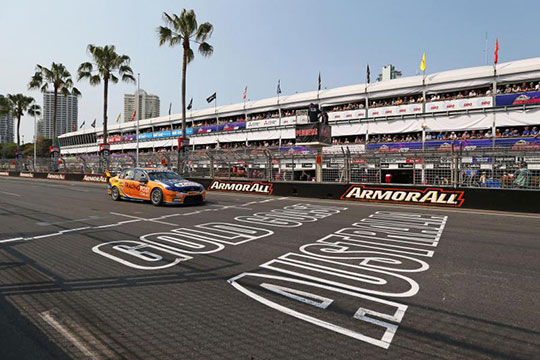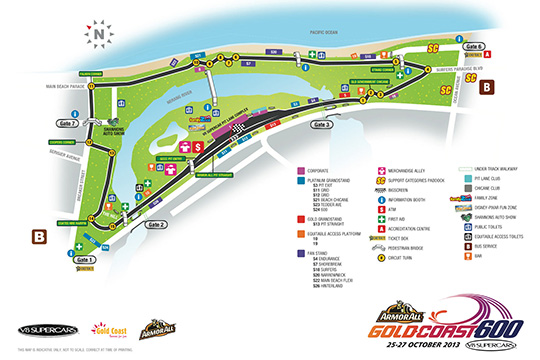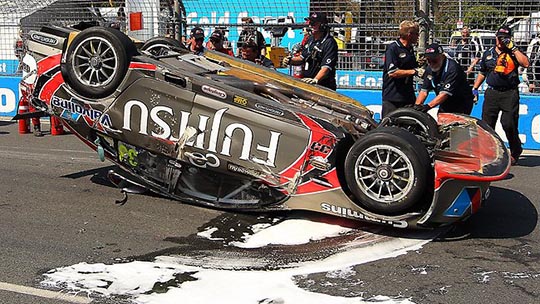
With just a two-week turn around after Bathurst, the V8 Supercars take to the streets of Surfers Paradise for the Armor All Gold Coast 600 in the fight to be crowned winners of the inaugural PIRTEK Enduro Cup.
With 300 points available over the two 300km races, 12 teams are still in contention to write themselves into V8 Supercar history by winning the third and deciding round of the unofficial ‘championship within a championship’.
The Enduro Cup will be awarded to the driver and co-driver combination with the most points scored over the course of the three endurance events – the Sandown 500, the Bathurst 1000 and the Gold Coast 600. Jamie Whincup and co-driver Paul Dumbrell lead the points standings with 576, a 42-point lead over nearest rivals and Red Bull teammates Craig Lowndes and Warren Luff (534), while Bathurst 1000 winners Mark Winterbottom and Steve Richards lie in third with 504. (see all 12 contenders below).
The current three day Gold Coast event comprises of a pair of gruelling 300km street circuit races set against the backdrop of one of the most famous beach-side cities in the world, the Queensland resort town of Surfers Paradise.
Over the course of its history here, the event has certainly been through a number of format changes.
V8 Supercars made their first appearance on the Gold Coast as a (non-Championship) support act to the IndyCars in 1994, and apart from 1995 have been on the bill every year since.
In 2002, the event was turned into a point-scoring championship round and comprised of three races across the weekend, sharing headliner status with the Champcar World Series, and then the Indy Racing League in 2008.
2009 then saw the V8 Supercars completely take over from Indy Cars as the headline event and the three-race format was scrapped in favour of two 300km races. As there were no co-drivers in this event, each 300km race was split into two 150km legs.
In 2010, the Indy track was shortened by approximately 1.5kms to its current length, and the international co-driver format was introduced.
For 2011 and 2012, all co-drivers were required to be of international standing, however the format has been relaxed for the 2013 Gold Coast 600 event to allow the teams to utilise their co-drivers from Sandown and Bathurst.
In order to provide economic parity, the V8 Supercars Commission has ruled that each car must use a minimum of 185 litres of fuel in each race this year. Teams can reach their minimum fuel intake in any combination they choose. This ruling differs slightly from the Sandown and Bathurst mandates which outlined a minimum number of pit stops.
As has been the case here since 2010, co-drivers are required to do a minimum of 34 laps in each of the 102 lap races.
Since 2005 the Gold Coast event has been dominated by Triple Eight Race Engineering, Walkinshaw Racing and Ford Performance Racing, the three teams claiming the last nineteen races straight. Triple Eight leads the way with eight victories to Walkinshaw Racing’s seven, while Ford Performance Racing are on four.

The Sunday race in 2012 saw Ford Performance Racing’s Will Davison break Triple Eight’s 11-race winning streak, which stretched from the Skycity Triple Crown at Darwin through to the Saturday’s Gold Coast 600 opener.

TheCircuit
The unforgiving Surfers Paradise street circuit features 15 turns across the 2.96 kilometre layout. The temporary circuit is high speed, and lined by concrete ready to punish any errant driving. Straying from the racing line can lead you straight into trouble.

The narrow nature of the circuit frequently causes carnage, none more so than Saturday’s race from 2012 where six cars were eliminated after two failed starts. The track features two sections of chicanes, turns one, two and three at the top end of the front straight, and then turns six, seven, eight, nine and ten along the back straight. These sections are typically patrolled with curb sensors to ensure that drivers aren’t cutting across the curbs in order to gain track position.
Length: 2.96km
Max Speed: 265km/h
Average Speed: 146km/h
Qualifying lap record: Jamie Whincup (2011) 1:10.9615, Holden Commodore VE II
Race lap record: Will Davison (2011) 1:10.0851, Ford Falcon FG (note: time was achieved after the corner bollards were removed and the curb sensors were turned off)
Tyre Allocation: 28 x Soft tyres only
Format
Friday:
4 x 40 minute Practice sessions
Saturday:
1 x 30 minute Qualifying session
1 x Top Ten shootout 1 x 300km race (102 laps)
Sunday:
1 x 30 minute Qualifying session 1 x 300km race (102 laps)
Past winners:
2012 – Jamie Whincup and Sebastien Bourdais / Will Davison and Mika Salo
2011 – Jamie Whincup and Sebastien Bourdais / Mark Winterbottom and Richard Lyons
2010 – Garth Tander and Cameron McConville / Jamie Whincup and Steve Owen
2009 – Garth Tander / Mark Winterbottom
2008 – Jamie Whincup (x3)
2007 – Garth Tander (x2) / Steven Richards
2006 – Rick Kelly / Garth Tander / Todd Kelly
2005 – Craig Lowndes (x2) /Greg Murphy
2004 – Greg Murphy / Marcos Ambrose
2003 – Russell Ingall (x2)
2002 – Jason Bargwanna / Greg Murphy
2001 – Garth Tander (x2) / Mark Skaife
2000 – Paul Radisich (x2) / Russell Ingall
1999 – Paul Radisich (x3)
1998 – Mark Larkham (x2)
1997 – Russell Ingall / Greg Murphy
1996 – John Bowe (x2)
1994 – John Bowe (x2)
PIRTEK Enduro Cup Points (after two rounds)
1. Whincup/Dumbrell – 576
2. Lowndes/Luff – 534
3. Winterbottom/Richards – 504
4. W.Davison/Owen – 450
5. Holdsworth/Baird – 366
6. McLaughlin/Perkins – 360
7. Tander/Percat – 318
8. Coulthard/Youlden – 306
9. Bright/Jones – 288
10. Van Gisbergen/Bleekemolen – 282
11. Reynolds/Canto – 276
12. Ingall/Briscoe – 276
